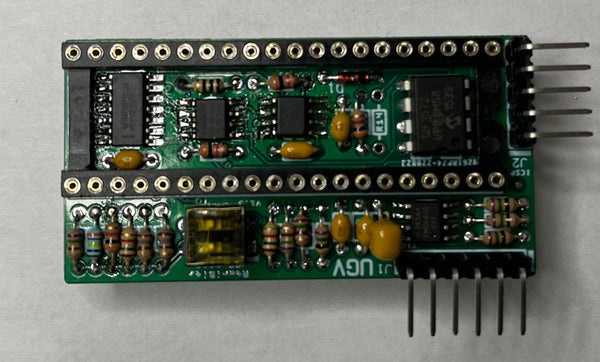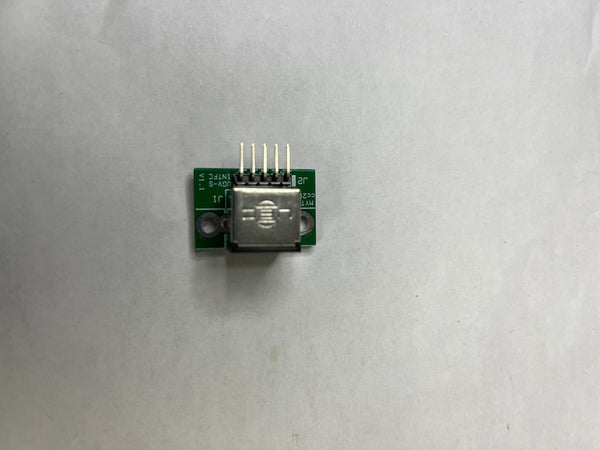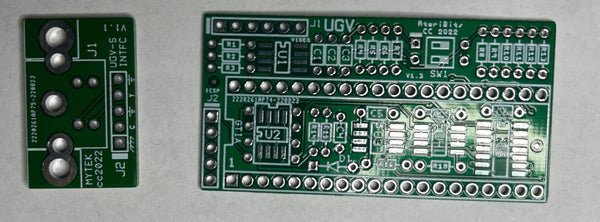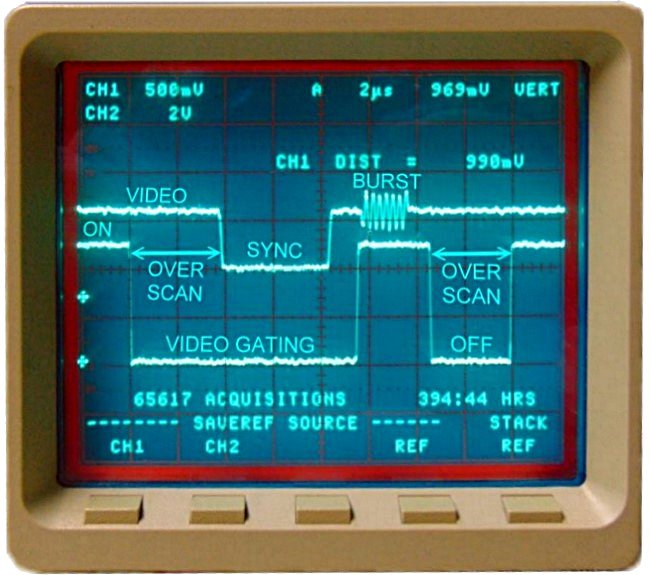Ultimate Gated Video by MyTek
MyTek is at it again! This time he has created some video goodness for the Atari 8-bit series of computers. The UAV (sold here) and the UGV are great ways to improve that video clarity for your Atari computers! We sell the UGV in four varieties:
Bare Boards: This is just a set of two bare printed circuit boards. MyTek has the BOM on the website (copied below)
SMD completed: This is a set of two boards with the SMD (surface mounted device) chips already soldered on. The rest of the tech used in the design is through hole. Again, MyTek has the BOM on the website (copied below).
Assembled & Tested: This is a set of two boards fully assembled and tested. It will still need to be installed in to your machine (as detailed in the website). This has two sub-vartiants"
With S-Video daughterboard: connecting dupont wires, assembled S-video daughterboard comes with the UGV
Without S-video daughterboard: UGV only (for those that want to wire it to internal video and/or have their own method of connecting S-video)
Thanks!
|
UGV Ultimate Gated Video Board
Back in the days of CRT TV's the visible image was cropped by what was called 'over scan' wrapped around the edges of the CRT picture tube. Later when computer monitors got cheaper, more people starting using them instead of their TV's. The side effect of this transition resulted in less of the over scan image being chopped off. To this day the trend has continued with the advent of modern HDTV's, which now display every bit of possible video coming out of the Atari 8-bit. As a result, some games and applications that take advantage of this normally 'hidden' area of the screen to hide various graphics manipulations (akin to racing the beam), now have all these unsightly artifacts revealed. So the main idea behind the UGV board is to hide these areas that were never meant to be seen, by 'blacking' them out. As part of its operation it also incorporates an entirely new HQ Video Driver Circuit with both composite and S-Video output quality being similar to what is seen in the UAV board created by AtariAge member Bryan. The UGV board is meant to piggyback the existing GTIA chip Atari P/N: CO14805 [NTSC] or CO14889 [PAL], thus providing a 'no solder' installation on the 400/800, and XL series machines. XE systems will require de-soldering the GTIA chip and installing a 40 pin socket. |
|
Precise timing of the video gating aspect is performed by an embedded PIC MCU clocked by the GTIA's OSC pin, and then boosted by a factor of 4x by an internal PLL. This synced high speed clock makes it possible to execute code in the PIC chip quickly enough to allow gating of the video signal at just the right moment in order to eliminate over scan by switching off the Luma and Chroma before subsequently being buffered and sent to the video outputs. This gating can be disabled by bringing the PDAT pin to ground (Vss), and with no connection, a +5V pull-up resistor on this pin defaults to an enabled state. Or in other words turns it ON.
Either a PDIP or SOIC device can be used as the MCU, programmed via the ICSP header (J2), or if it is a PDIP device it can be socketed and programmed externally if so desired. However use of the PDIP package will require an additional stacked 40 pin IC socket in order for the bottom of the GTIA chip to clear the top of the PIC. |
Due to global supply shortages these chips may be out of stock at most traditional sources. However I had good luck sourcing the PIC12F1572-I/SN in a SOIC-8 package from AliExpress. |
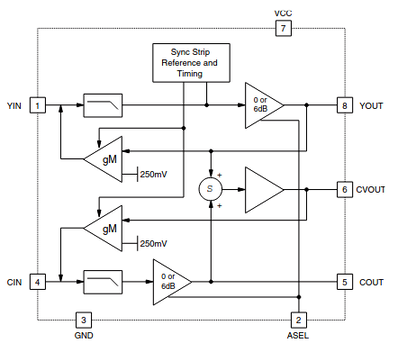 FMS6400 Block Diagram
FMS6400 Block Diagram
To insure that the minimum amount of noise gets introduced in this process, the FMS6400 is used in its 0 db gain mode, while the resistor DAC is composed of very low ohm values driven by a 74HCT08 Quad 'AND' Gate having much higher drive current than the CD4050 buffer chip used in the original Atari video circuit.
Using the low ohm (low impedance) resistors for the DAC's ladder makes them far less susceptible to picking up switching noise from the immediate area. The overall result produces very clean noise-free video while keeping the signal paths simple and direct.
Although the FMS6400 is an obsolete chip, it really does such a superb job for this application that it's worth buying NOS from the likes of eBay or AliExpress. And it's readily available from those sources, being sold at a very reasonable cost of less than $1.00 each (that price includes shipping when purchased in lots of 5 pieces or more). It's commonly sold as FMS6400, FMS6400CS, FMS6400CS1 which are all essentially the same part.
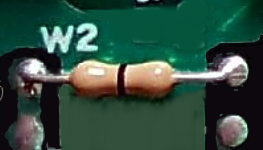 W2 Jumper
W2 Jumper
The fix is easy, and amounts to either cutting one lead on the jumper or removing it all together. in either case the jumper was never required, and there will be no detrimental effect to leave it out permanently.
On all XL and XE systems it's identified as 'W2' on the motherboard's silk screen, and is either located close to the main oscillator and crystal on an XL unit, or close to the unpopulated PAL Color Burst oscillator circuit where the 74LS74 would normally be located if it were an XE PAL machine. The 74LS74 is designated as U21 on the 65XE and 130XE, or as U10 on an XEGS.
The 1200XL is the exception to this rule, and although it too has a place for a jumper (designated as 'W10' instead), it apparently was never installed in most, or maybe all of those machines. So no modification is likely to be needed. And lastly the 400/800 series didn't even have a jumper and left the NTSC GTIA pin 16 unconnected, which is what we want.
 Female to Female Jumper Wires
Female to Female Jumper Wires
When a fully assembled board is piggybacked with the Atari's GTIA chip, the UGV instantly becomes a fully functional device with minimal external connections required other than the video outputs. Which in most cases consists of a couple of soldered points on the Atari motherboard in order to feed the stock 5-pin DIN A/V jack (reference TBA's UAV manual for locations).
And for those that wish to have an industry standard S-Video Mini-DIN connection, there's also an optional interface board available that enables a solder-less interconnection utilizing pre-made off the shelf jumper wires (check out the BOM for a source of these).
Because of space constraints, the GTIA socket needs to be de-soldered and removed, and the UGV needs to get soldered in its place. Also the ICSP header (J2) needs to be left off the assembly.
 UGV on 400/800 6502 CPU Card (later SALLY version has GTIA on far left)
UGV on 400/800 6502 CPU Card (later SALLY version has GTIA on far left)
Even though the UGV utilizes a low profile piggyback design, unfortunately in these older systems there's virtually no room between the CPU Card and the cast aluminum shielding, thus it won't clear the inside of the shield with the GTIA socket still in place.
Also on the later SALLY CPU Cards the video connection header (J1) will interfere as well, so it'll need to be left off the assembly and have wires soldered instead.
Lastly in all versions, the edge card socket of the Atari will interfere with the ICSP header, so it too must be removed from the UGV if present. The PIC chip will need to be flashed with a temporary header pressed in place.
Due to a non-buffered color connection to GTIA, the stock video will not look good with the UGV installed, and especially if the VGATE function is enabled. Therefore it is meant to entirely replace the stock video coming out of your Atari. Since the UGV is all about getting High Quality video output, there is no real sacrifice in no longer using the original stock video circuits. In fact it just makes good sense to cut loose the original video connections going to the A/V jack, and instead route the UGV video outputs to that same jack.




